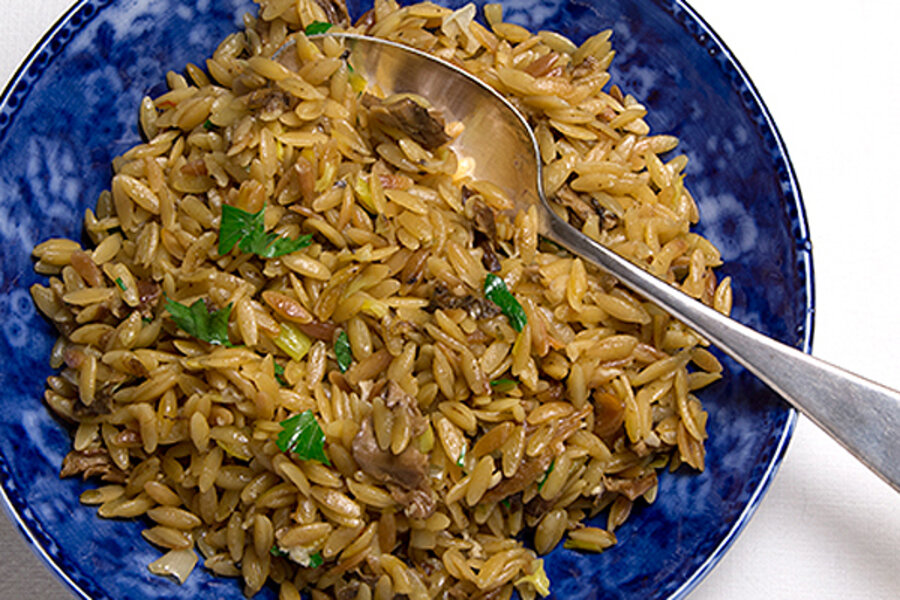Risotto-style orzo with Porcini mushrooms
For years, we bought rice in 25-pound sacks at an Asian market, and we went through those sacks at an alarming rate. Until finally, we didn’t. The change wasn’t abrupt, but it was there. The giant sacks of rice were lasting longer, then ultimately becoming impractical, taking up too much room in our cramped pantry.
Partly, it was that Marion was veering away from the delicious, but sometimes involved Chinese dinners that had been a mainstay of her cooking. And partly, it was that she was cooking less, as I began to muck about more in the kitchen. My attempts were all over the map, but rarely included Asian cuisine at that point. So, gradually, pasta pushed rice aside – in our pantry and on the table.
We don’t buy pasta in 25-pound sacks, but we do seem to go through a lot of linguine, fusilli, capellini, penne, and other more esoteric shapes. And curiously, even though we’re always buying it, we often seem to be out of the particular style we need when we’re cooking.
Recently, I’ve been seeing recipes for cooking orzo, the tiny rice-shaped pasta, risotto-style, first sautéing it in oil or butter and then adding the cooking liquid a little at a time, letting the orzo absorb it slowly. To me, substituting orzo for rice offers a couple of advantages. First, while you stir the orzo frequently, it doesn’t demand the relentless stirring most risotto recipes require. And second, at least to my palate, pasta has a less aggressively starchy flavor than rice, letting other flavors take the lead.
The recipe below is definitely that – you’ll find precise measures and (I hope) clear directions. But it’s as much a technique as a specific dish. Feel free to experiment at will. Substitute fresh mushrooms for the dried porcini I used. Add fresh peas or spinach. Skip the saffron. Swap a shallot for the leek. All that said, the saffron and the mushrooms (and their soaking liquid) gave this version a wonderful earthiness, as did the Parmesan. And the lemon juice was indispensable, adding a note of brightness at the end. As a side dish, it has a subtle complexity that sneaks up on you, rewarding you more with each bite.
Risotto-style orzo with porcini mushrooms
4 to 6 servings as a side
1 ounce dried porcini mushrooms
3 to 4 cups reduced sodium chicken broth
A pinch of saffron threads
2 tablespoons dry vermouth (optional—see Kitchen Note)
1 tablespoon olive oil
2 tablespoons unsalted butter
1 leek, white and light green part halved lengthwise, then cut into thin half moons
3 cloves garlic, minced
1 teaspoon dried tarragon
12 ounces dried orzo
Salt and freshly ground black pepper
1/2 cup freshly grated Parmesan cheese
2 tablespoons lemon juice
2 tablespoons chopped fresh parsley
1. Put the dried porcini mushrooms in a medium bowl and add 1-1/2 cups boiling water. Let the mushrooms steep for 10 minutes or so. Line a mesh strainer with a coffee filter or bit of paper towel and drain the mushrooms over a bowl, reserving the liquid. Rinse the mushrooms under cold running water and pat dry with paper towels. Chop coarsely and set aside. In a medium saucepan, combine the reserved mushroom liquid and enough broth to equal 4 cups. Heat the broth mixture over a low flame to just simmering as you prepare the other ingredients.
2. Add the pinch of saffron threads to the vermouth (if using) and set aside. (Take a moment to notice later how the saffron tints the vermouth a deep yellow – this is one of the fun little secret moments of cooking.)
3. In a medium saucepan or sauté pan (I used the latter), heat the oil and butter over a medium flame, swirling them together. Add the leeks and sweat until soft and translucent, stirring frequently, about 3 minutes. Add the garlic and tarragon and cook until fragrant, about 45 seconds, stirring constantly. Add the orzo and stir to coat with the oil and butter. Season with salt and pepper and cook for about 5 minutes, stirring frequently.
4. Stir in the mushrooms, then add the vermouth and saffron threads. Cook for about 1 minute, stirring to combine. Reduce heat to low.
5. Ladle in 1 cup of the broth mixture, stirring to combine. Cook, stirring frequently, but not obsessively. As the orzo absorbs the broth, add more, 1/2 cup at a time. This is all somewhat subjective. By the first 10 minutes of the 30 minute cooking time, I had used half of the broth and was getting mildly concerned. Don’t worry. Unless the heat is too high, you’re not going to end up with a pasta version of fried rice.
6. Do cook it the full 30 minutes, stirring frequently. The orzo will become nice and tender, without taking on that gummy quality you can sometimes get with true risotto. Turn off the heat and stir in the Parmesan, lemon juice and parsley. Taste and adjust the seasonings with salt and pepper. Serve.
Kitchen Notes
Do I really need the vermouth? No. If you have it on hand it adds a nice little note to this already note-rich dish. But if you don’t drink – or do drink, but don’t keep vermouth on hand – just add the saffron threads with the garlic and tarragon.
Related post on Blue Kitchen: Saffron Pasta with Roasted Mushrooms, Caramelized Onions and Bell Pepper






